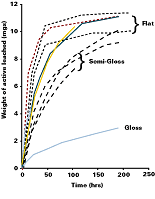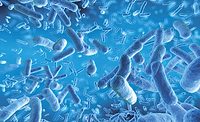In the past, it has been standard practice to judge a molecule based on the outcome of standard microbiological tests. To exploit fully the available biocides, it is important to apply chemistry know-how to understand why molecules behave as they do in different matrices and identify ways for improving their performance.

Making Better Use of Existing Molecules - Opportunities for Polyhexamethylene Biguanide as a Preservative
The majority of in-can preservatives are non-selective electrophiles, which kill microorganisms by reacting covalently with thiol or amino groups present in enzymes that catalyze essential metabolic processes. The non-selective nature of these products means that they display broad-spectrum activity. Their mode of action means that it is difficult for bacteria to develop tolerance unless the biocides are underdosed for long periods or become overwhelmed due to poor hygiene practices. However, it is always useful to have access to alternative biocides such as biguanides, which have a different mode of action (see Figure 1). Molecules containing the biguanide group kill bacteria and fungi by a different mechanism and provide a useful addition to the usual battery of electrophilic preservatives. They are also very potent against the most common spoilage bacteria such as pseudomonads, which possess a protective outer membrane.



Studies with artificial multilamellar vesicles made from different lipids have shown that PHMB binds strongly to anionic or non-ionic membranes. The very strong affinity of PHMB for negatively charged molecules means that it can interact with some common anionic (but not cationic or nonionic) surfactants used in coatings formulations. However, it is compatible with polyvinyl alcohol, cellulosic thickeners and starch-based products and works well in polyvinyl acetate and vinyl acetate-ethylene emulsion systems. It also gives good performance in silicone emulsions and cationic electrocoat systems. Simple compatibility tests quickly show if PHMB is compatible with a given formulation and stable systems can often be developed by fine-tuning anionic components.

Understanding the Behavior of Molecules in Real Systems - Mildewcides in Paint Film
As was the case for preservatives, a limited number of molecules is available for paint film protection. Paint film mildewcide formulations are usually evaluated by incorporating them into paint at different dose levels and running standard tests on draw-downs to check for compatibility (e.g., absence of yellowing, chalking, fading etc.). Laboratory efficacy tests can give an indication of performance but the true test of a mildewcide formulation is its ability to prevent mildew defacement for several years under real-world conditions in fence tests.The common factor in these evaluations is that growth of fungal organisms is used to obtain the end point. In principle, the efficacy of a mildewcide depends on a combination of factors including its potency against a variety of key fungi that cause defacement and its ability to leach from the film at an appropriate rate so that an effective dose is maintained at the surface of the film following repeated exposure to moisture. A snapshot of what is happening at the surface of the film can be obtained by monitoring mildewcide leaching using chemical analysis (see Figure 5).
The data shows that the leaching kinetics can vary dramatically for different molecules when the paint film is exposed to moisture. The overall trend suggests that aqueous solubility of the mildewcide is a major determinant of leaching kinetics. Indeed, it was not possible to measure any leaching of chlorothalonil (aqueous solubility 6mg/l) under conditions where other actives were readily detected. The films also became susceptible to fungal defacement at the point when the mildewcide depot was exhausted.


Conclusion
The two broad conclusions of this work might have been expected intuitively. However, to our knowledge this is the first time that mildewcide leaching has been measured with any degree of precision and related to the physical properties of the mildewcide or paint. The results show that leaching studies can serve as a useful tool to screen new formulations for acceptable leaching performance and to evaluate technologies for modifying the mildewcide release rate (e.g., microencapsulation).For more information on biocides, contact Avecia Biocides, 1405 Foulk Road, 2nd Floor, PO Box 15457, Wilmington, DE 19850-5457; phone 800/523.7391; fax 302/477.8120; visit
www.aveciabiocides.com.
Sidebar: AveciaBiocides
Avecia Biocides is one of the highly specialized businesses within Avecia, the new name for the former Zeneca Specialties business following completion of the $2.1-billion (£1.3) buyout from AstraZeneca. Avecia’s new identity was launched on Sept. 1, 1999.U.S. headquarters is located in Wilmington, DE, with manufacturing plants in Charlotte, NC, and Mount Pleasant, TN. In addition, it has sales, research and manufacturing sites in many parts of the world, including Europe, Latin America, Japan, and Asia-Pacific. The global headquarters is located in Manchester, UK.
Avecia Biocides commits its global resources to safeguarding customers’ products and manufacturing processes from micro-organisms and the contamination they cause. Avecia Biocides protects your company’s profitability by preserving your products’ integrity, quality and performance.
Technologies
Avecia is a broadly based business built around core skills in organic synthesis, polymer chemistry, biological chemistry and process technology. Products are targeted at specific biocides-related growth sectors. Avecia Biocides offers preservatives, antifungals, disinfectants and sanitizers for almost every need. A variety of formulations exist, to facilitate ease of handling and compatibility with each particular product. All businesses maintain an active portfolio of research collaborations with academia and other external institutions, and scientific staff is encouraged to develop these to ensure the company remains at the forefront of technology in their chosen market areas. Illustrating this, this article presents two technical summaries relating to the use of these skills to fully exploit antimicrobials for coatings.
Technical Services
Avecia Biocides combines microbiological testing with analysis skills, helping paint companies to solve their problems. Avecia’s technical service team specializes in the areas of microbiology, analytical and formulation chemistry, and plant hygiene, to name a few. We realize that sometimes “standard” procedures alone aren’t enough. Accordingly, your Avecia Biocides team offers both standard and customized support services, based on an examination of your plant, processes and products. Part of our service includes regulatory, safety, health and environment support, plant hygiene audits, and personalized training at many levels.


Report Abusive Comment